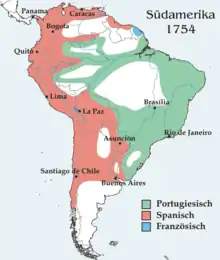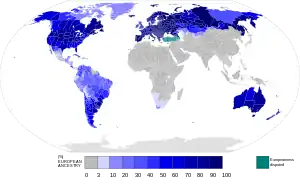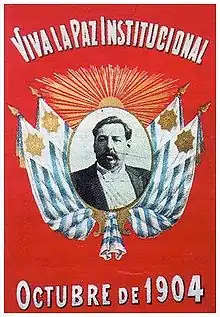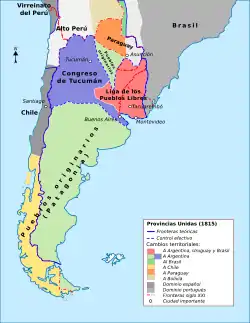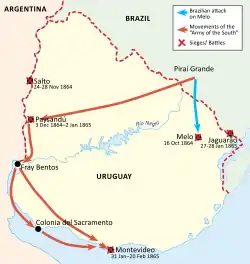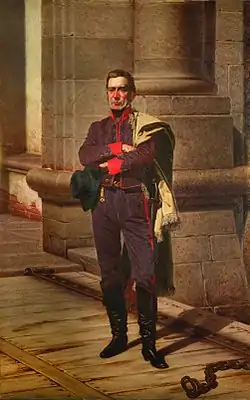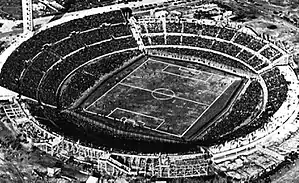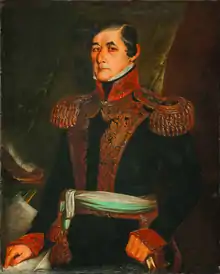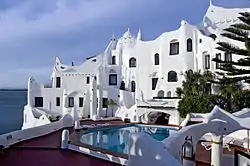| Portal | Participants | Templates | Tasks | Assessment | Popular Pages | Requests |
The Uruguay Portal
Uruguay (/ˈjʊərəɡwaɪ/ ⓘ YOOR-ə-gwy, Spanish: [uɾuˈɣwaj] ⓘ), officially the Oriental Republic of Uruguay or the Republic East of the Uruguay (Spanish: República Oriental del Uruguay), is a country in South America. It shares borders with Argentina to its west and southwest and Brazil to its north and northeast, while bordering the Río de la Plata to the south and the Atlantic Ocean to the southeast. It is part of the Southern Cone region of South America. Uruguay covers an area of approximately 181,034 square kilometers (69,898 sq mi) and has a population of around 3.4 million, of whom nearly 2 million live in the metropolitan area of its capital and largest city, Montevideo. The area that became Uruguay was first inhabited by groups of hunter–gatherers 13,000 years ago. The predominant tribe at the moment of the arrival of Europeans was the Charrúa people. There are also other tribes Guarani, Chaná when the Portuguese first established Colónia do Sacramento in 1680. Uruguay was colonized by Europeans late relative to neighboring countries. The Spanish founded Montevideo as a military stronghold in the early 18th century because of the competing claims over the region. Uruguay won its independence between 1811 and 1828, following a four-way struggle between Portugal and Spain, and later Argentina and Brazil. It remained subject to foreign influence and intervention throughout the 19th century, with the military playing a recurring role in domestic politics. A series of economic crises and the political repression against left-wing guerrilla activity in the late 1960s and early 1970s put an end to a democratic period that had begun in the late 19th century, culminating in the 1973 coup d'état, which established a civic-military dictatorship. The military government persecuted leftists, socialists, and political opponents, resulting in deaths and numerous instances of torture by the military; the military relinquished power to a civilian government in 1985. Uruguay is today a democratic constitutional republic, with a president who serves as both head of state and head of government. Uruguay is ranked first in the Americas for democracy, and first in Latin America in peace, low perception of corruption, and e-government. It is the lowest-ranking South American nation in the Global Terrorism Index, and ranks second in South America on economic freedom, income equality, per-capita income, and inflows of FDI. Uruguay is the third-best country on the continent in terms of Human Development Index, GDP growth, innovation, and infrastructure. Uruguay is regarded as one of the most socially progressive countries in Latin America. It ranks high on global measures of personal rights, tolerance, and inclusion issues, including its acceptance of the LGBT community. The country has fully legalized cannabis (the first country in the world to do so) as well as same-sex marriage, prostitution, and abortion. It is a founding member of the United Nations, OAS, and Mercosur. (Full article...) Selected article -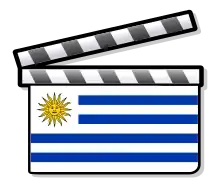 Selected picture -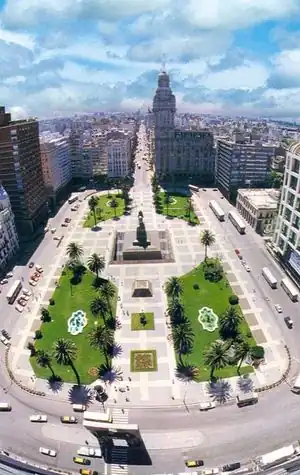 Plaza Independencia, Ciudad Vieja
Did you know -
CategoriesSelect [►] to view subcategories
Uruguay Uruguay-related lists Buildings and structures in Uruguay Uruguayan culture Economy of Uruguay Education in Uruguay Geography of Uruguay Government of Uruguay Health in Uruguay History of Uruguay Organizations based in Uruguay Uruguayan people Politics of Uruguay Society of Uruguay Uruguay stubs People -
Carlos Páez Vilaró (1 November 1923 – 24 February 2014) was a Uruguayan abstract artist, painter, potter, sculptor, muralist, writer, composer and constructor. (Full article...)
General imagesThe following are images from various Uruguay-related articles on Wikipedia.
Related portalsTopicsRecognized content
Featured articlesGood articlesAssociated WikimediaThe following Wikimedia Foundation sister projects provide more on this subject:
Award
Things you can do
Articles that need Attention
Discover Wikipedia using portals
| |||||||||||||
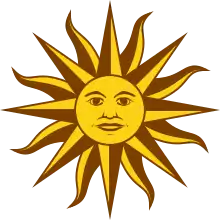
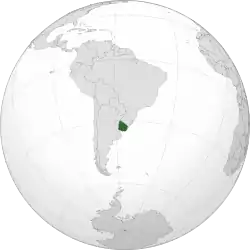


.jpg.webp)


